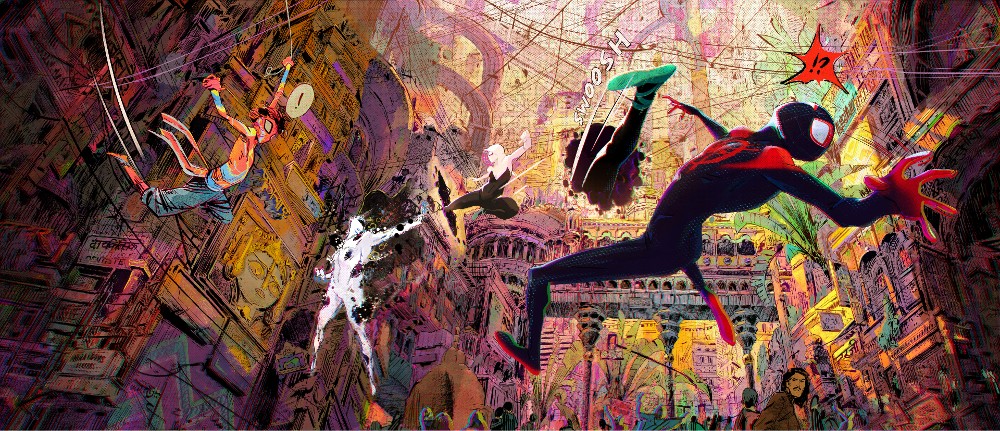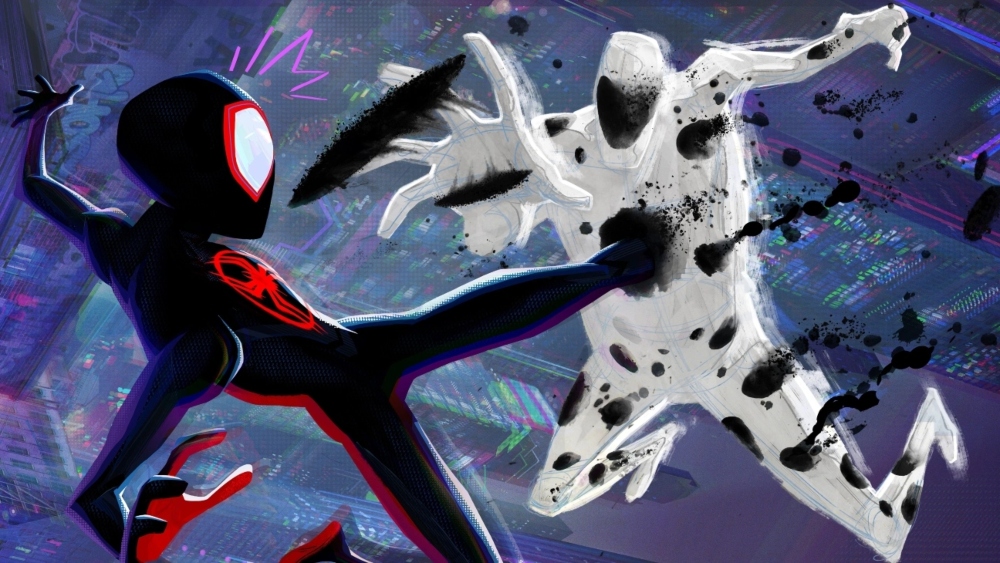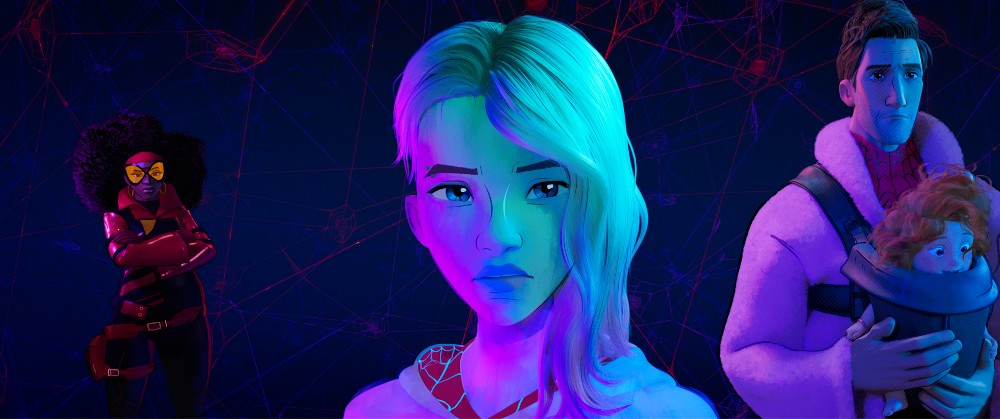
Michael Semanick is a frequent veteran of Lord-Miller projects so it was a no-brainer that he found himself working on Spider-Man: Across the Spider-Verse as the re-recording mixer.
Semanick had himself a busy year going from Spider-Verse to Teenage Mutant Ninja Turtles: Mutant Mayhem without as much of a break. The sound mixer tells Below the Line that mixing the film was one of the largest post-production projects that he worked on next to The Lord of the Rings movies. The film went to many worlds with a lot voices and music and that required a “delicate balance.” Semanick says that setting the textures and tone for each world was among the film’s biggest challenges.
Spider-Man: Across the Spider-Verse is the sequel to the 2018 Oscar-winning film. The film sees Miles Morales and Gwen Stacy venture across the Multivese and meet other Spider-People protecting its existence. In battling Spot and his dangerous scheme, it puts Miles at odds against some of the other Spider-People. He also has to face the reality that there are some constants in every universe no matter who was bitten by the radioactive spider. It means attempting to save his father from a fate that has befell others.
BTL: Given your history working on Lord-Miller projects, I’m assuming it was a quick yes to working on Spider-Man: Across the Spider-Verse?
Michael Semanick: Of course, yeah. I was not going to miss that. After working on the first one and seeing what they did, I knew, Okay, if it’s Chris and Phil and the directors is that they’re going to up it and I’m in. So yeah, it was an easy yes. In fact, I kept prodding Phil, when are we gonna start? When are we going to start? Let’s get it going.
BTL: Between Spider-Verse and Teenage Mutant Ninja Turtles: Mutant Mayhem, did you have any breaks while working on the two titles?
Semanick: No, I went straight from Spider-Verse right into Teenage so it was really tight. I went jumped right off of Spider-Verse, right into that one so not a break, not until after Teenage Mutant.
BTL: What was the mixing process like for Spider-Verse this time around?
Semanick: Juan Peralta was mixing the effects and it was similar to the other one. We started a little earlier to get a jump on things and to get things more in order. We ended up doing long hours, the picture was changing, shots were just coming in. There’s a lot of voices involved in that and Daniel’s score and Metro Boomin. The mixing was—I would say it was a lot of delicate balances. We had all the different worlds we had to go into so it was a huge undertaking and took a lot of time.
We’re very fortunate that Sony Animation and Pam Marsden and everybody gave us the time and spent the money to do it because it was huge. It was probably one of the largest post-production things I’ve ever worked on other than Lord of the Rings, and I think they’re right in the same amount of energy and stuff we had to do.

BTL: I was talking with Mike Andrews and he was saying that it was running around three hours before they decided to just split it into two films.
Semanick: Yeah, I didn’t really get involved. Phil had called me about that and said, “Look, we’re gonna have to split this into two. We’re sorting it out. I’m just letting you know, there’s gonna be a third.” He gave me a heads up. Didn’t say much more than that, just that they were really onto something and they felt really good about it but it was too long. They didn’t want to wear the audience out like that. I think that was a wise choice.
The second one’s longer than most animated features are but it doesn’t feel that way to me when I watch it. It didn’t feel that way when I was with audiences. Audiences were clamoring for more. My son called me and was like, “You can’t end it like this—I want more!” It was never a talk about the length of the film. No one ever that I have met or talked about that film had ever talked like, oh, it’s way too long. No one’s ever said that.
All I got was, Can’t wait for the next one. I wish they could have kept—people wanted it to keep going. I think in the Marvel world like that and some of those movies like Avengers: Endgame, people wanted those to keep going. You get so wrapped up in it. It really does take you on a journey and it’s really fun to be on that journey and you don’t want it to stop sometimes. But hey, after a while, your butt gets sore after sitting in the seat.
BTL: What was it like working with this trio of directors?
Semanick: It was really fun and it was a lot of work. Everybody has ideas and everybody has a sonic soundscape that they want. A lot of the directors were in charge of those worlds and when you’re animating those worlds, I’m sure they’re thinking about what they sound like. A lot of people had ideas in there. Geoffey Rubay and his crew came up with a lot of different things. We weeded through stuff and Juan was really good about, well, we only need to really hear this and we only really need to hear that and we really got to keep the story points going, but we want to create an atmosphere in each one.
Once you do that, you can pull back a little bit and let the audience just fall into that world still. You can establish it and then let them fall into it. Going into Mumbattan, it’s busy, it’s noisy, it’s honking its horns and then you can pull back a little bit and really let the audience absorb it. It’s funny how you can pull sound down and around and people still feel it’s very active. It’s a fascinating brain thing that happens in listening and watching picture.
BTL: How involved were Lord and Miller in the process?
Semanick: They’re very involved. They have all the experience. They have guided this thing so everybody just kind of listens to them as far as like, “Hey, this is what we think should happen here and this is our idea, we see what’s coming down the road in the next one,” which I’m not privileged to. It’s like, this will make sense later so they were very involved in it. I think everybody was because the passion in this film and in the storytelling—they’re very passionate about it. Everybody involved was very passionate about it, which you love to see, and it can create some arguments and it can create some tensions. But the end goal is we want the audience to enjoy themselves, we want them to enjoy the storyline. I think that’s the end goal.
We have to earn their respect, their ears, and their eyes. When they always kept that in mind, Chris and Phil were really good about—Chris is really good about, we’ve got to respect the audience here, let’s not bombard them, let’s not do that. Visually, we’re bombarding them, let’s not do it with sound and visuals. Let’s pick our point. Phil’s very good at like, yes, here we go.
Everybody involved was just working together as a team, which is really fun actually. Makes it really fun because everybody had the same end goal. Like I said, we want to earn the respect of the audience in the storytelling, and we want to keep them captivated and moving forward. I think we achieved that. I feel like we have so it’s really fun for me to go watch it again fom time to time. I usually don’t on most movies. I tend to step away for a while but I’ve really had fun watching this movie with audiences.
BTL: When some of your past filmography includes films that are three hours long, that is a commitment!
Semanick: (Laughs) That’s for sure.
BTL: I rewatched King Kong this year for the first time since theatrical.
Semanick: Wow. Good for you. Yeah, that’s a three-hour thing.
BTL: When you add on the bonus features, it’s even more.
Semanick: Oh, yeah, I know. I still can’t figure out how people can sit through all three extended versions of Lord of the Rings in one day. I know people who have and I have friends who have and they go to the theater where they’re playing them and they’re there for 12 hours. I’m like, I couldn’t do it. I couldn’t do it, man. That is some dedication. If the films capture you like that, God bless you, man. I wish I had that in me to watch that many hours. But maybe because I worked on them and as you sometimes look at these films from the past, you realize what things you went through to achieve sound and to achieve this. Sometimes I miss sight of the film a little bit, looking back, going, wow, we worked so hard and so many hours. I forget that I’m supposed to be wrapped up in the film and not think about that stuff but sometimes I do.
BTL: Back to the film, what were some of the biggest challenges that came with working on the sequel?
Semanick: Some of the biggest challenges, again, were setting the textures and tones of each world. Those were some of the biggest challenges as we went into each world. The music, between Daniel Pemberton and Metro Boomin, and mixing those together—they were a lot of tracks and really trying to make it feel cohesive. I had a lot of fun mixing that stuff, really a lot of fun.
There’s a really great track that Miles is listening to—I think it’s the James Blake track—where he puts his headphones on and I had a lot of fun mixing that. He’s spinning around the room, he’s lost in that song, and then Gwen comes in. That was a challenge. It took me quite a while to get there. I’m very happy with a lot of it but that was one of the areas I thought, wow, this sounds really good to me.
When Gwen and Miles is on the tower and they’re talking, the whole world spins upside down. They go upside down. Juan and I both spun the music around. Daniel had a little stinger there that I swung with that thing. Not that I think audiences feel it but it was just one of those scenes where it was very delicate in what was being played and you got to pay attention to their dialogue.
There’s so many different scenes with Spot and going into different areas that were challenging. When he goes into his world there, there’s a great line. He’s like, Echo Echo, oh, there’s no echo here, which there is no echo there. He’s doing it but there are those areas where we wanted to make it—we had a lot of different directions and we were kind of waiting for some of the animation to come through to see, oh, what should we be doing here and how should we be doing it. When those started coming through, the animation does help you go, Oh, this is what we need to do with the sound. This is what we need, we need to thin this part out and put this in or the music seems to complement this better.
Those were some of the scenes but throughout the whole film, I mean, it seems like every day we hit a new area and it’d be like, Okay, here we go, we’re going here now and we’ve got to make this with Gwen and the lasers and the Spot playback thing work and all the talking back and forth with those areas and Miles is there and he’s eavesdropping. I can keep going it. The whole scene when Gwen gets mixed up and they’re trying to find Miles and he’s back in a different dimension and the audience doesn’t know yet. Keeping that—those were really—it’s raining in one and it’s not in the other. We took a lot of great painstaking care with the sound through each one of those in the back half of that film and that took a while.
It took quite a while because we didn’t want to give it away. We wanted the audience to think and kind of lead the audience and then let the audience figure it out before it’s revealed almost. Some people in the audience did figure it out before it’s revealed and then it’s revealed that, Oh, God, he’s in the wrong—yeah, those were some of the most difficult areas.

BTL: Is there much difference working on sound mixing for animation than there is for live-action?
Semanick: I approached them pretty much the same. Sound has to be prepped. I think sound teams approach them the same. It is true with live-action, you have recorded dialogue that’s from the set, from the street or location recordings that you usually have to use. The dialogue in animated films is all ADR so every environment has to be established in cut and figured out. There is some of that that goes on but even in live-action, sound teams—if we are in New York City, they’re cutting New York City backgrounds, even though part of the production sound will have New York City background because you can’t avoid it but you want to complement it. There’s not a huge amount of difference for me.They both take a lot of work and a lot of sound prep. It just depends, I think, on the movie.
Spider-Verse was one of the more difficult animated film, the second one, because we’re trying to up it from the first one. All the different locations, they’re all new, and what do they sound like? Those kinds of decision-making, I find a little bit more difficult than live-action because we’re in New York City, we’re in Chicago, we’re in Ohio somewhere in a field or a jungle and you kind of know what those sound like? Not that it makes it any easier but you’re already given a set of organics from the planet. I don’t know. I guess that’s my answer. Is that okay?
BTL: Yeah. That was everything I had since I asked some of my other usual questions last time around.
Semanick: Okay. I love the movie. Well, I love them both. I’m hoping I’ll be there for the third one. Never assume but I’m sure I’ll be in the mix when it comes time to mix that movie.
BTL: I’m looking forward to seeing it.
Semanick: Me, too. I have no idea what’s happening in that film and that’s fine. I’m good. They keep that pretty close to their hearts and rightfully so. My time will come and then I’ll get to see it and then hopefully by when I get to see it, it’s only a couple, two-three months before the world gets to see it.
BTL: Yeah, that’s where people like me are very jealous of you.
Semanick: (Laughs) Well, thank you.
Spider-Man: Across the Spider-Verse is now available to stream.





